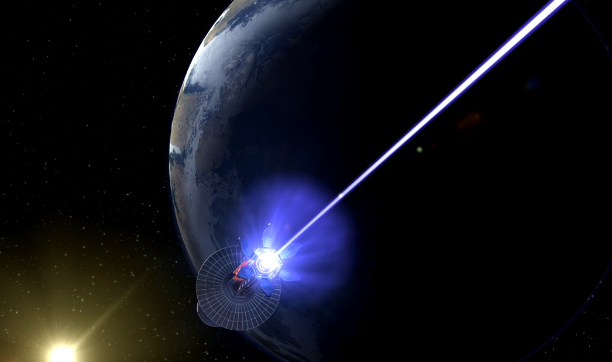
NASA’s announcement this week that astronomers using the Kepler Space Telescope have just discovered another 1,284 exoplanets (new worlds that exist beyond the realm of our own solar system) makes the short film Cosmic Journeys: Interstellar Flight even more fantastically mind-bending viewing, with its use of CGI, history and science-based fiction to explain how the next era of space exploration might unfold as we venture further into the universe.
Some 550 of the newly found planets are believed to be rocky ‘terrestrial’ bodies, like Earth and Mars (as opposed to big balls of gas like Jupiter and Saturn). Around 100 are Earth-like or smaller, and nine of these are potentially orbiting their host star within the ‘habitable zone’, which means they’re spinning around in the sweet spot, where the surface temperature could be right for liquid water to exist—a factor considered by scientists to be a prerequisite for life as we know it to exist.
All we have to do now is to figure out a way of getting a closer look, to see if we really are sharing this moment in time and corner of the universe with alien species, be it a full-blown civilisation of intelligent beings, or a bunch of bacteria—the mere prospect of bumping into any form of life beyond our own planet is pant-wetting exciting for many people, because once it’s shown to be possible, then we have the rest of the universe to scour.

One of the parallels the documentary draws is to compare space exploration with the Western World’s discovery of the Pacific Ocean in the 16th Century. The Pacific is easily the largest body of water on Earth, but the people of Europe didn’t know about it until Spaniard Vasco Núñez de Balboa wandered across the isthmus of Panama in 1513. Seven years later, Portuguese navigator Ferdinand Magellan led an expedition that rounded the tip of Cape Horn and properly explored the ocean, en route to completing the first full circumnavigation of Earth.
Economics and advancements in ship-building techniques and sea-faring technology powered the Age of Discovery that followed, during which entire new civilisations were found scattered across the Pacific and remoter regions of the Indian Ocean, including Australia, New Zealand, Fiji, Hawaii and all the outposts of Polynesia, such as Easter Island. And if the explorers were surprised at what they encountered, imagine what it must have felt like for the aboriginal people of those lands—for them, alien ships were literally landing and life would never be the same again.
Our own planet continues to reveal extraordinary surprises, so just imagine what might lie waiting out there in the potentially liveable parts of our galaxy. Dr Natalie Batalha, Kepler mission scientist at Nasa’s Californian Ames Research Centre, says that calculations suggest there could be more than 10 billion potentially habitable planets in the Milky Way alone.

Could these include worlds such as Pandora, envisaged in the sci-fi epic Avatar? James Cameron located his story on a made-up moon orbiting a fictional gas giant called Polyphemus in the very real solar system of Alpha Centauri, the brightest ‘star’ visible in the constellation of Centaurus. (The real Alpha Centauri is actually a trinary star system—three stars orbiting around one another, made up of two Sun-like stars, Alpha Centauri A and Alpha Centauri B, plus a red dwarf, Alpha Centauri C—but let’s not split hairs.)
Alpha Centauri might be our nearest interstellar neighbour, but it’s still 4.37 light years away, and as the documentary explains, that poses some pretty big problems for modern-day Magellans seeking to push the boundaries of discovery. To put things in perspective, the film explains that Voyager II, which recently became the first human-made object to travel beyond our solar system, and which is hurtling along at an impressive 62,000 kilometres per hour, would take 73,000 years to reach Alpha Centauri even if managed to maintain that speed.
To speed things up and get to Alpha Centauri within, say 50 years, space craft would have to be capable of travelling at about a tenth of the speed of light (30,100 kilometres per second), and to do this new technologies will need to be created, and sources of power harnessed. In Avatar, the interstellar ships are driven by antimatter and, like many sci-fi themes, this fictional concept has a handhold on scientific reality. Antimatter exists, and it’s potentially the most powerful fuel in universe, with just a tenth of a gram of the mysterious stuff being capable of powering a space ship from Earth to Jupiter.
Unfortunately, it’s also pretty volatile, potentially super dangerous, and is naturally created in the most violent corners of the universe, such as in the maelstrom of supermassive black holes. The ability to manufacture antimatter is already within our grasp, with technology in use in CERN‘s Large Hadron Collider in Switzerland, but it would currently cost an estimated 100 trillion dollars to produce one gram.
Will we, as a species, invest the funds to make this kind of interstellar exploratory travel possible? With the number of people living on Earth rising at an alarming rate, climate change intensifying land pressure and resources such as food and fresh water becoming increasingly stretched, many people think we may have to—including Dr Stephen Hawking, who recently told an audience at Sydney’s Opera House: ‘I don’t think we will survive another 1,000 years without escaping beyond our fragile planet.’
Hawkins recently threw his support behind the Breakthrough Starshot program, which aims to send unmanned craft to Alpha Centauri within 20 years.
Fleeing our globe to seek sanctuary in space is a concept that’s as confronting as it is fascinating, but will the need ever arise, and will we be ready to run if and when it does? Watch Cosmic Journeys: Interstellar Flight and make up your own mind.
